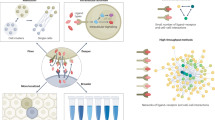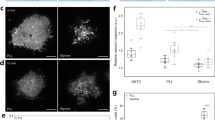Abstract
Do cell-surface growth-factor receptors and their ligands accumulate in the nucleoplasm under physiological conditions? And, if so, how do they get there and what function do they serve in this location? Recent advances have provided tantalizing hints to the answers to these questions, and hold the key to identifying a new mode of signal transduction.
This is a preview of subscription content, access via your institution
Access options
Subscribe to this journal
Receive 12 print issues and online access
$189.00 per year
only $15.75 per issue
Buy this article
- Purchase on Springer Link
- Instant access to full article PDF
Prices may be subject to local taxes which are calculated during checkout


Similar content being viewed by others
References
Hunter, T. Signaling — 2000 and beyond. Cell 100, 113–127 (2000).
Schlessinger, J. Cell signaling by receptor tyrosine kinases. Cell 103, 211–225 (2000).
Wells, A. in Hormone Signalling (eds Goffin, V. & Kelly, P. A.) 57–80 (Kluwer Academic, Norwell, Massachusetts, 2002).
David, M. et al. STAT activation by epidermal growth factor (EGF) and amphiregulin: requirement for the EGF receptor kinase but not for tyrosine phosphorylation sites or JAK1. J. Biol. Chem. 271, 9185–9188 (1996).
Marti, U. & Wells, A. The nuclear accumulation of a variant epidermal growth factor receptor (EGFR) lacking the transmembrane domain requires co-expression of a full length EGFR. Mol. Cell Biol. Res. Commun. 3, 8–14 (2000).
Lin, S. Y. et al. Nuclear localization of EGF receptor and its potential new role as a transcription factor. Nature Cell Biol. 3, 802–808 (2001).
Reilly, J. F. & Maher, P. A. Importin β-mediated nuclear import of fibroblast growth factor receptor: role in cell proliferation. J. Cell Biol. 152, 1307–1312 (2001).
Offterdinger, M., Schofer, C., Weipoltshammer, K. & Grunt, T. W. c-erbB-3: a nuclear protein in mammary epithelial cells. J. Cell Biol. 6, 929–940 (2002).
Ni, C.-Y., Murphy, M. P., Golde, T. E. & Carpenter, G. γ-Secretase cleavage and nuclear localization of erbB-4 receptor tyrosine kinase. Science 294, 2179–2184 (2001).
Basu, M., Biswas, R. & Das, M. 42,000-molecular weight EGF receptor has protein kinase activity. Nature 311, 477–480 (1984).
Mroczkowski, B., Mosig, G. & Cohen, S. ATP-stimulated interaction between epidermal growth factor receptor and supercoiled DNA. Nature 309, 270–273 (1984).
Basu, M. et al. EGF receptor-associated DNA-nicking activity is due to a Mr-100,000 dissociable protein. Nature 316, 640–641 (1985).
Raper, S. E., Burwen, S. J., Barker, M. E. & Jones, A. L. Translocation of epidermal growth factor to the hepatocyte nucleus during rat liver regeneration. Gastroenterology 92, 1243–1250 (1987).
Marti, U. et al. Localization of epidermal growth factor receptor in hepatocyte nuclei. Hepatology 13, 15–20 (1991).
Katoh, M. et al. K-sam encodes secreted as well as transmembrane receptor tyrosine kinase. Proc. Natl Acad. Sci. USA 89, 2960–2964 (1992).
Marti, U. et al. Nuclear localization of epidermal growth factor and epidermal growth factor receptors in human thyroid tissues. Thyroid 11, 137–145 (2001).
Bargmann, C. I., Hung, M. C. & Weinberg, R. A. Multiple independent activations of the neu oncogene by a point mutation altering the transmembrane domain of p185. Cell 45, 649–657 (1986).
Longo, N. et al. Activation of insulin receptor signaling by a single amino acid substitution in the transmembrane domain. J. Biol. Chem. 267, 12416–12419 (1992).
Xie, Y. & Hung, M.-C. Nuclear localization of p185neu tyrosine kinase and its association with transcriptional transactivation. Biochem. Biophys. Res. Commun. 203, 1589–1598 (1994).
Heldin, C.-H. & Ericsson, J. RIPping tyrosine kinase receptors apart. Science 294, 2111–2113 (2001).
Marti, U. & Hug, M. Acinar and cellular distribution and mRNA expression of the epidermal growth factor receptor are changed during liver regeneration. J. Hepatol. 23, 318–327 (1995).
Burke, P., Schooler, K. & Wiley, H. S. Regulation of epidermal growth factor receptor signaling by endocytosis and intracellular trafficking. Mol. Biol. Cell 12, 1897–1910 (2001).
Wells, A. Molecule in focus: EGF receptor. Int. J. Biochem. Cell Biol. 31, 637–643 (1999).
Oksvold, M., Huitfeldt, H., Stang, E. & Madshus, I. Localizing the EGF receptor. Nature Cell Biol. 4, E22 (2002).
Waugh, M. G. & Hsuan, J. J. EGF receptors as transcription factors: ridiculous or sublime. Nature Cell Biol. 3, E209–E211 (2001).
Pederson, T. Growth factors in the nucleolus. J. Cell Biol. 143, 279–281 (1998).
Swindle, C. S. et al. Epidermal growth factor (EGF)-like repeats of human tenascin-C as ligands for EGF receptor. J. Cell Biol. 154, 459–468 (2001).
Lee, H. J. et al. Presenilin-dependent γ-secretase-like intramembrane cleavage of ErbB4. J. Biol. Chem. 277, 6318–6323 (2002).
Acknowledgements
We apologize to the many authors whose works were not cited here owing to both space limitations and the focus on the EGFR family. Our work was supported by grants from the National Institutes of Health (NIGMS and NCI), the Veterans Administration and the Swiss National Science Foundation.
Author information
Authors and Affiliations
Corresponding author
Rights and permissions
About this article
Cite this article
Wells, A., Marti, U. Signalling shortcuts: cell-surface receptors in the nucleus?. Nat Rev Mol Cell Biol 3, 697–702 (2002). https://doi.org/10.1038/nrm905
Issue Date:
DOI: https://doi.org/10.1038/nrm905
This article is cited by
-
EGFR signaling promotes nuclear translocation of plasma membrane protein TSPAN8 to enhance tumor progression via STAT3-mediated transcription
Cell Research (2022)
-
Targeting c-Myc with a novel Peptide Nuclear Delivery Device
Scientific Reports (2020)
-
The identification of nuclear αvβ3 integrin in ovarian cancer: non-paradigmal localization with cancer promoting actions
Oncogenesis (2020)
-
Evaluating nuclear translocation of surface receptors: recommendations arising from analysis of CD44
Histochemistry and Cell Biology (2020)
-
Possible mechanisms and function of nuclear trafficking of the colony-stimulating factor-1 receptor
Cellular and Molecular Life Sciences (2014)



